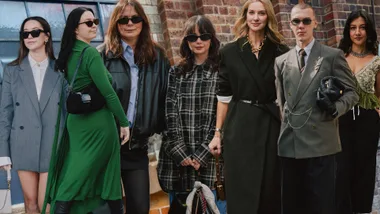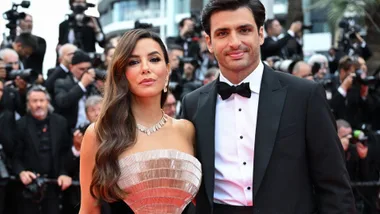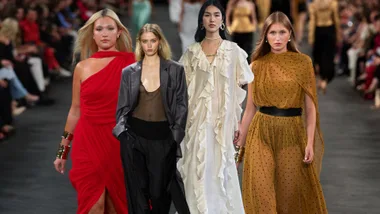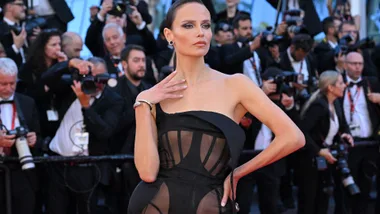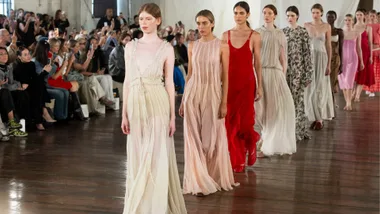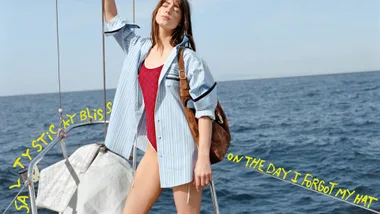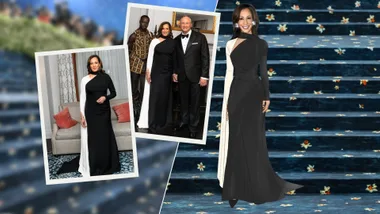The buzz around Copenhagen Fashion Week SS25 showcase last week wasn’t merely about the designs – it was about the statement those designs were making. As the world of fashion becomes increasingly eco-conscious, Denmark’s capital is setting the pace, with a lineup of designers who are as committed to the planet as they are to their craft.
Forget about sustainability being a side note; at CPHFW, it’s front and centre, woven into every stitch, drape, and silhouette that graced the runway. From Lovechild 1979’s timeless elegance to OperaSPORT’s edgy, seasonless pieces, these collections didn’t just turn heads – they turned the tide on what sustainable fashion can be.
So, if you’re not already across them, these are the designers rewriting the rules on sustainable fashion.
Stem
On the opening day of CPHFW SS25, Stem captivated audiences with a collection that completely redefined what sustainable craftsmanship looks like in 2024. The brand’s founder, Sarah Brunnhuber, introduced a groundbreaking weaving technique, ironically the result of an “imperfection” in the fabrics she was receiving from mills where the material had been stretched and pulled, resulting in unique pleated effects.
“Fabrics would arrive where the loose weave would sometimes be pushed and pulled and gathered in certain spots, and that was just so beautiful to me,” Brunnhuber tells marie claire. “So, rather than throwing it out, I started to play around with it in a more considered way and eventually built up a line of samples which I would then intentionally pull and manipulate to turn them into a garment.”
Each piece in the collection is zero-waste, made exclusively from certified natural or recycled fibres, ensuring that the brand’s environmental impact is minimal. Brunnhuber’s dedication to creating new handcraft techniques, especially in an era dominated by fast fashion, speaks to Stem’s mission of marrying innovation with eco-conscious practices to offer timeless pieces for the everyday, making a compelling case for the future of slow, sustainable fashion that’s, at its core, stylish.
Marimekko

The Finnish design house is known globally for its bold prints and vibrant colours, however, Marimekko’s sustainability efforts aren’t to go unnoticed. The brand’s collection at CPHFW was a testament to its ongoing dedication to reducing environmental impact while maintaining its iconic aesthetic.
This season, Marimekko focused on reimagining its classic prints through the use of more sustainable materials and processes, including garments made from organic cotton, recycled polyester, and sustainably sourced wool, while also introducing a new print, Jäkälä , designed on the principles of a circular economy.
“With Copenhagen Fashion Week having such high standards for sustainability, it’s really encouraging to be part of this bigger ambition towards more sustainable actions in the fashion industry,” Marimekko’s Creative Director, Rebekka Bay tells marie claire.
In its SS25 collection, the brand experimented with new dyeing techniques that reduce water usage and minimise waste, aligning with its broader goal of achieving full circularity by 2025, proving that style and sustainability can coexist beautifully.
OpéraSPORT
Known for its chic, modern silhouettes and an inherent commitment to sustainability, OpéraSPORT’s SS25 collection was yet another iteration of the brand’s vision for seasonless, versatile pieces that transcend trends.
Co-founded by Stephanie Gundelach and Awa Malina Stelter, the new collection featured garments made from recycled materials, including repurposed silk and recycled polyester, ensuring that each piece is as sustainable as it is stylish. The palette featured muted earth tones – think soft taupes, dusty pinks, and deep olives – interspersed with bold pops of colour, offering a fresh take on transitional dressing.
Silhouettes ranged from oversized blazers and flowing skirts to structured dresses and sleek bodysuits, all designed with versatility in mind, making them perfect additions to a wardrobe that values both style and longevity.
The brand’s approach to sustainability is holistic, operating with a transparent supply chain, working closely with its manufacturers to reduce waste and ensure ethical labour practices. And this commitment to sustainability does not compromise the brand’s design philosophy; instead, it enhances it, bringing luxury fashion that resonates with the modern, eco-conscious consumer.
We love to see it.
ECCO
While ECCO may not have hit the runway at CPHFW, the brand made some serious waves with its innovative activation held on Tuesday in collaboration with RAL7000 Studio. The activation invited guests to personalise their own pair of sneakers from the collaboration using a selection of natural dyes and ethical materials to immerse consumers in ECCO’s vision of a stylish, eco-conscious future.
“Being a Danish brand, we’re always looking for new ways to lessen our impact on the environment,” says Justin Daughrity, Ecco’s Head of Brand. “Whether it’s using natural dyes, working closely with dairy and cattle farmers, or introducing new technology that can be adopted across the industry, without compromising on quality or luxury.”
The leather industry is one of the most fraught when it comes to sustainability but ECCO is one brand trying to change the narrative. At the heart of ECCO’s sustainability efforts is their revolutionary DriTan technology.
Traditional tanning processes guzzle water like there’s no tomorrow, but ECCO’s DriTan flips the script by using the moisture already present in hides. This clever innovation saves up to 20 litres of water per hide and prevents about 600 tons of sludge from ending up in landfills each year – a win for the planet, and for the wardrobe.
Joao Maraschin

Brazilian designer Joao Maraschin made a powerful statement at CPHFW with a collection that fused cultural storytelling with ethical production. Known for his socially responsible approach to fashion, Maraschin’s SS25 collection was a highlight for many at CPHFW, showcasing a vibrant celebration of artisanal craftsmanship, featuring handwoven textiles, intricate embroidery and draped silhouettes that had the whole room swooning over his designs.
His goal? To preserve traditional techniques but also provide economic opportunities for those involved in the process. Maraschin works closely with artisans from regions often overlooked by the global fashion industry, ensuring that their skills are not only preserved but also celebrated on an international stage.
Maraschin’s commitment to sustainability is also evident in his choice of materials, which include organic cotton, linen, and recycled fibres, all of which are consciously chosen for their timelessness and durability, encouraging consumers to invest in garments that will last. His approach challenges the fast-fashion mentality, advocating for a slower, more mindful consumption of fashion.
Lovechild 1979

Lovechild 1979’s SS25 runway was a masterclass in sustainable luxury. The brand’s creative director, Anne-Dorthe Larsen, emphasised the importance of creating pieces that could be cherished for years through a showcase of classic silhouettes with contemporary twists using sustainably sourced materials like organic cotton, Tencel, and recycled wool.
The collection itself was a beautiful balance of understated chic and thoughtful craftsmanship. Soft, muted tones of beige, cream, and pale blue dominated the runway, with occasional pops of deep navy and earthy browns, creating a versatile palette. The designs ranged from oversized blazers and tailored trousers to fluid midi dresses and structured button-down shirts, each piece exuding a sense of effortless elegance and embodying the concept of “future heirlooms,” where every piece stands the test of time, both in style and durability.
The brand’s focus on quality over quantity was clear, with basic garments like button-down shirts and tailored pants elevated by the choice of premium, sustainable fabrics and structured designs. Larsen’s vision for the collection was not just about creating clothes but about crafting pieces that could be passed down through generations, blending style with substance in a way that encourages a more mindful approach to fashion and serves as a reminder that sustainability and luxury are not mutually exclusive.
 Getty
Getty
